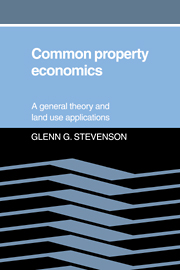Book contents
- Frontmatter
- Contents
- List of Tables and Figures
- Preface
- 1 What Is Common Property?
- 2 Open Access Theory
- 3 Common Property
- 4 The Swiss Grazing Commons
- 5 Comparisons with the English Open Field System
- 6 An Econometric Comparison of Commons and Private Grazing
- 7 The Structure and Performance of Common Property: Conclusions
- References
- Index
7 - The Structure and Performance of Common Property: Conclusions
Published online by Cambridge University Press: 16 September 2009
- Frontmatter
- Contents
- List of Tables and Figures
- Preface
- 1 What Is Common Property?
- 2 Open Access Theory
- 3 Common Property
- 4 The Swiss Grazing Commons
- 5 Comparisons with the English Open Field System
- 6 An Econometric Comparison of Commons and Private Grazing
- 7 The Structure and Performance of Common Property: Conclusions
- References
- Index
Summary
In the concluding chapter of this book, I wish to explore further the description of Swiss common property from Chapter 4 in order to generalize Swiss commons management techniques to other resource exploitation contexts and to reexamine the conclusion from the empirical work of Chapter 6 that the average productivity of Swiss commons is lower. Both these discussions draw on the theoretical discussions of Chapters 2 and 3. Accordingly, this chapter is divided into two parts. In the first, I consider some of the principles of limiting entry and user decision making that come from the Swiss grazing commons, and review the practicality of applying some of the principles to other natural resources. In the second major section, I examine the question “How well do commons work?” The empirical results of Chapter 6 seem to say that they do not work as well as private property, but the results must be interpreted with a critical eye before we reach this conclusion.
Common Property Principles in Swiss Grazing
A number of principles of natural resource control are imbedded in the practices pursued by Swiss commons users and rights holders. These include input quotas and input rights, seasonal restrictions, limiting the user group by residency or family lineage, and backward linkage or complementary input restrictions. The Swiss grazing commons also illustrate various forms of commons decision making, which have implications for the sharing and shifting of costs and the viability of user self-government.
Information
- Type
- Chapter
- Information
- Common Property EconomicsA General Theory and Land Use Applications, pp. 214 - 235Publisher: Cambridge University PressPrint publication year: 1991
